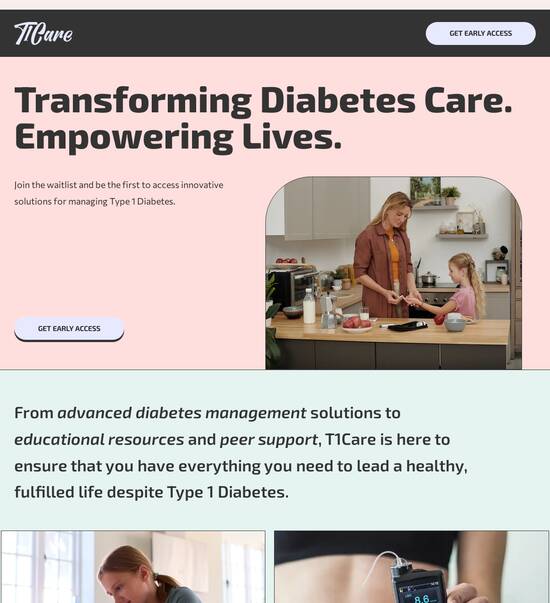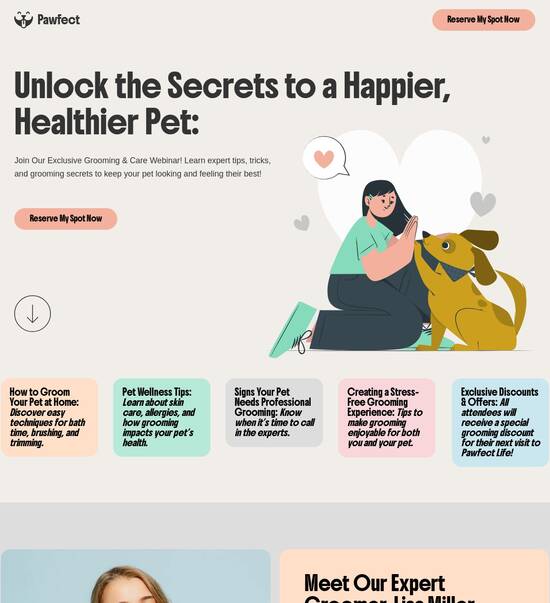
HTML page template with interactive privacy policy form
Explore Similar TemplatesAbout template
Use HTML page templates with interactive privacy policy form and make your communications easy and transparent. Try our solution today.
Recommended templates

Easy to build without coding
With the intuitive drag-and-drop builder, anyone on your team can create high-converting pages without any knowledge of code or design. Make enhancements to your landing page with custom widgets using Javascript, HTML/CSS, or third-party scripts.

Multiple layouts for any industry and goal
Select from 500+ landing page layouts built to boost conversions across industry-specific scenarios. Customize them by adjusting fonts, adding images, and generating on-brand content with the AI assistant. Quickly scale with Instablocks® and Global Blocks that you can save, reuse, and update globally.

Loads fast and looks polished on any device
Every template is responsive, which means they present professionally on any device and load blazingly fast with our Thor Render Engine. You can also power them up with Google AMP technology to deliver an unparalleled mobile experience and drive higher conversions.

Robust analytics & experimentation
Get real-time updates and reporting across all your devices, showing the number of visitors, conversions, cost-per-visitor, and cost-per-lead. Launch AI-powered experiments, run A/B tests, and use heatmaps to analyze user behavior, then optimize your landing page to maximize conversions.







Easy to build without coding
With the intuitive drag-and-drop builder, anyone on your team can create high-converting pages without any knowledge of code or design. Make enhancements to your landing page with custom widgets using Javascript, HTML/CSS, or third-party scripts.
Multiple layouts for any industry and goal
Select from 500+ landing page layouts built to boost conversions across industry-specific scenarios. Customize them by adjusting fonts, adding images, and generating on-brand content with the AI assistant. Quickly scale with Instablocks® and Global Blocks that you can save, reuse, and update globally.
Loads fast and looks polished on any device
Every template is responsive, which means they present professionally on any device and load blazingly fast with our Thor Render Engine.
Robust analytics & experimentation
Get real-time updates and reporting across all your devices, showing the number of visitors, conversions, cost-per-visitor, and cost-per-lead. Launch AI-powered experiments, run A/B tests, and use heatmaps to analyze user behavior, then optimize your landing page to maximize conversions.
All the features you need to build privacy policy html template bootstrap
Explore more featuresLearn how to build privacy policy page template html css
Frequently asked questions about privacy policy html css template
Leading the way in building high-performing landing pages





Privacy policy page design html: Your ultimate how-to guide
The ability to craft effective landing pages is essential for any marketing team, particularly in sectors like business services, tech, and education. Instapage offers an all-in-one solution for building and optimizing landing pages, ensuring that marketers can transform their digital campaigns efficiently. With over 100 ready-made templates and a user-friendly interface, creating high-converting pages is straightforward.
Step 1: Choose the right template for your campaign
Selecting a template that aligns with your campaign goals is crucial. Instapage provides diverse options that cater to various industries. Consider templates that resonate with your target audience in the USA, whether you're in financial services or marketing and advertising, to ensure relevance.
- Focus on user experience: Templates designed with the end user in mind lead to lower bounce rates.
- Consider your CTA: A good template highlights the call-to-action effectively.
- Responsive design: Ensure the template is mobile-friendly, given the high number of mobile users.
Step 2: Optimize your landing page for conversions
Optimization begins with understanding user behavior. Instapage allows you to utilize built-in heatmaps and A/B testing to see what works best. Determine which layout leads to the highest conversions and refine accordingly.
- Use heatmaps to identify areas attracting the most clicks.
- Conduct A/B tests with different copy to see which resonates best.
- Implement analytics to track user journey from landing page to conversion.
Step 3: Personalize the user experience
Personalization increases engagement and conversions. Instapage provides dynamic text replacement, which allows you to tailor experiences to each user. This is essential in industries like education and tech, where messaging can differ significantly based on the audience's background.
- Utilize dynamic text replacement for on-page personalization.
- Segment audiences for targeted messaging.
- Align specific ad campaigns with unique landing pages to drive relevant traffic.
In conclusion, using Instapage not only simplifies the landing page creation process but also empowers marketers to take control of their conversion rates. The built-in optimization and personalization features ensure that every visit to your landing page is a meaningful interaction.
Ready to boost your campaign's ROI? Start using Instapage today and see how easy it is to create landing pages that perform!
People also ask about privacy policy page html css
HTML page template with interactive privacy policy form
Understanding the foundations of an interactive privacy policy form
The importance of privacy policies cannot be overstated in the context of modern web design. They serve as fundamental documents that inform users about how their data is collected, used, and protected. In a world where data breaches are frequent and privacy concerns are paramount, businesses must prioritize clear and concise privacy policies. Developing user trust hinges significantly on transparency around data practices, making it essential for organizations to communicate this information effectively.
Moreover, privacy policies hold legal implications as well, with various regulations such as GDPR and CCPA imposing requirements on organizations regarding data protection. A well-structured privacy policy not only safeguards the rights of users but also helps companies fulfill their compliance mandates. Thus, implementing an interactive privacy policy form embedded within an HTML template becomes a critical aspect of ensuring user engagement and normative compliance.
Essential features of an HTML template for privacy policies
When designing an HTML template for privacy policies, user-centric design considerations are paramount. It is crucial to ensure that the privacy policy is easily visible and accessible, leading to increased engagement. The design should also cater to mobile responsiveness, allowing users to read the policy conveniently on any device. Good aesthetics play a significant role too; a clean, professional layout fosters a sense of trust among users, encouraging them to delve deeper into the information presented.
In addition to clarity and accessibility, an interactive privacy policy form includes various engagement features. Clickable elements and user-friendly form fields invite users to participate rather than passively read the policy. These interactive components not only enhance user comprehension but also serve to inform users about their rights regarding the handling of their personal data. For instance, incorporating dynamic content, such as FAQs that expand when clicked, can effectively educate users while keeping the interface clean and user-friendly.
Crafting an effective privacy policy template
To create an effective privacy policy template, it is vital to incorporate core elements that address the key aspects of data collection, usage, and user rights. Essential sections should include detailed descriptions of the types of data collected, the purposes for which it is used, and clear statements regarding user rights, such as the right to access and correct personal information. This straightforward approach minimizes confusion and empowers users by clearly outlining their choices concerning their personal data.
Using clear language that embodies transparency is critical in promoting user trust. For instance, utilizing bullet points to list out user rights like data access and modification allows for easy reference and understanding. Customization options are also vital; organizations should be able to tailor their templates to reflect their unique data practices and company branding. Incorporating examples of well-customized privacy policies from successful companies can provide valuable insights into how to develop a transparent, user-friendly document.
Empowering users by educating on data rights
Highlighting user rights within a privacy policy is crucial for fostering an informed user base. Users have fundamental rights concerning their personal data, such as the right to access, correction, and even deletion under specific conditions. Clearly outlining these rights within the privacy policy not only educates users but also reassures them of their power concerning their personal information. Incorporating interactive elements, such as checkboxes that users can click to confirm understanding of specific rights, makes the experience more engaging.
This empowerment through information can lead to better compliance within organizations, as users are more likely to exercise their rights when they understand them. Thus, an interactive privacy policy form should foster an environment where users feel comfortable engaging with their data rights, a key element in developing long-term user relationships built on trust and transparency.
Transparency in data collection practices
A detailed explanation of data practices enhances transparency within a privacy policy. Clearly delineating the types of data collected—such as personal identifiers, usage data, and cookies—and stating the purposes for which these data are used is essential. For instance, understanding that data may be employed to improve service delivery, enhance user experience, or target advertisements becomes imperative for users. A visual guide, such as infographics that illustrate data flows, can further simplify complex information, allowing users to grasp the nuances of data processing at a glance.
Trust is heavily influenced by transparency. When organizations lay bare their data practices, users are more likely to feel secure sharing their information. Case studies show that firms that prioritize clear communication regarding their data collection methods often enjoy higher levels of trust and customer loyalty. Therefore, embedding transparency into privacy policy templates is crucial not only for compliance but also for cultivating robust customer relationships.
Enhancing user experience through clear security practices
Communicating security measures effectively to users is vital in establishing confidence regarding data protection. Organizations should offer an overview of common security practices, such as encryption methods, access controls, and secure storage solutions. This information should not be overly technical; rather, it should be relayed in a straightforward manner that emphasizes how these practices specifically protect the user's data.
By detailing security protocols within the interactive privacy policy form, organizations can provide users with reassurance. When users see that comprehensive measures are in place to guard their information, it fosters a sense of safety and builds trust. This is not just a best practice but an increasingly necessary element in creating a responsive and user-friendly website.
Compliance and regulatory considerations
Navigating legal frameworks is a crucial aspect of developing an effective privacy policy template. Regulations such as GDPR and CCPA present stringent requirements that organizations must adhere to when handling user data. Complying with these regulations involves clearly outlining what personal data is collected, the purposes of data usage, and how users can exercise their rights. Thus, a comprehensive privacy policy template must integrate these legal requirements to protect organizations from potential penalties.
Furthermore, organizations should adopt recommended practices for testing their privacy policies for legal compliance. Utilizing tools and checklists can be invaluable resources in this process, ensuring that all necessary elements are addressed and correctly represented. By doing so, organizations can navigate the complex landscape of data privacy laws confidently and provide a compliant and user-friendly experience.
The interplay between user data and trust
To build trust through responsible data management, organizations must prioritize ethical practices regarding personal information. This includes strategies that encourage users to share their data willingly while promoting transparency on how their information is utilized. Organizations can implement trust-building initiatives like user-friendly data access and correction processes, allowing users to feel in control of their data.
The impact of a robust privacy policy on user retention and loyalty cannot be discounted. When users feel assured that their data is handled responsibly, they are more inclined to engage with the brand and share information on an ongoing basis. This relational dynamic highlights the necessity of having a strong, interactive privacy policy to cultivate user loyalty and trust over time.
Designing an HTML page template with interactive features
To effectively design an HTML page template with interactive components, it is crucial to incorporate responsive and adaptive design elements. Best practices dictate that templates should seamlessly adjust across different devices and browsers to ensure a consistent user experience. This adaptability is essential in today’s digital landscape where user preferences vary widely across platforms.
Technical aspects of creating an interactive template include employing code snippets that facilitate the inclusion of interactive forms, as well as ensuring accessibility. Accessibility features, such as screen reader compatibility and keyboard navigability, enhance the user experience for those with disabilities. Moreover, best practices for testing interactive components are essential to confirm functionality and fix any issues before deployment.
Future trends in privacy policies and user interaction
As user expectations evolve, organizations must stay ahead of trends surrounding privacy and data security. Users increasingly demand clarity and control over their personal data, necessitating regular updates to privacy policies that reflect these needs. Forward-thinking organizations will find ways to anticipate changes and respond proactively, maintaining their relevance in a rapidly changing digital environment.
Innovations in web design that enhance user interaction will likely play a vital role in future privacy policies. Technologies, such as AI and machine learning, can be utilized to personalize user experiences according to their data preferences and behaviors. Organizations that leverage these technologies can not only meet user expectations but also provide customized privacy experiences that strengthen user trust and engagement.
Ready to skyrocket conversions?
Supercharge your ad campaigns with high-performing landing pages
Get started














